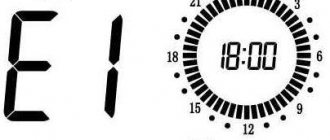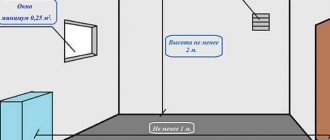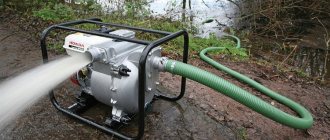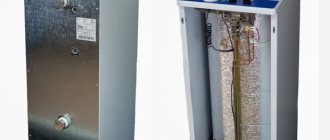When installing a gas boiler at home, the owners hope that the radiators in the rooms will be hot, and the unit itself will function stably, providing good heating in the house. However, no one is immune from breakdowns. Let's try to figure out why the gas boiler turns off and what other malfunctions may arise during the operation of the equipment.
Modern heating boilers are very reliable, but no one is immune from breakdowns. Most often, malfunctions of heating boilers arise as a result of operating errors, as well as if inaccuracies were made during installation.
If the owners notice that the equipment is not working well, and the radiators in the rooms are cold despite the fact that the boiler is set to the maximum level, you need to stop the unit and find out the cause of the problem. Most likely, you won’t be able to find out the cause of the breakdown on your own, so it’s better to immediately call a specialist from the service center.
Localizing the problem of boiler malfunction
With the development of modern low-rise construction and gas networks, the boiler has become a common household appliance in every house or apartment. Basically, after installation, the boiler does not cause users any trouble. Modern boilers operate completely autonomously and require only regular maintenance or inspection. In our opinion, the average operating time of units before the first breakdown is from 4 to 6 years. Some users encounter problems even after 9 years, and some, on the contrary, earlier. In this material I will tell you what can be done if the boiler simply does not turn on, and I will also consider the most common malfunctions of gas boilers. The concept of “does not turn on” can mean completely different problems:
- There is no indication (the display is not lit)
- The boiler does not light up
- The boiler does not operate in any particular mode
Therefore, these different situations should be considered separately in detail. Please note that to eliminate some malfunctions, user intervention is sufficient, but in some cases it is necessary to call a qualified specialist.
What models are there?
The main types of Lemax gas boilers are:
- Floor-standing models with steel or cast iron heat exchanger.
- Wall mounted solid fuel.
The solid fuel type of equipment is represented by two models:
- Wood stoves.
- Coal boilers.
Wall-mounted boilers are produced only as double-circuit boilers: they are capable of operating at pressures up to 3 bar. In all cases, Italian automation and circulation pumps are used. Wall-mounted models include a 6-liter expansion tank. This equipment is guaranteed for 2 years. Floor-mounted modifications equipped with steel heat exchangers are also in high demand. For their manufacture, high-strength metal with a thickness of 2 mm is used.
There are 5 models of steel boilers with different capacities:
- Lemax premium.
- Premium nova.
- Gazovik.
- Clever.
- Patriot.
The Premium nova model is considered the most advanced today. Thanks to automatic settings, the device can independently both start a Lemax gas boiler and set optimal operating parameters in the system. The Patriot series devices are characterized by the presence of a closed combustion chamber. They are produced exclusively as single-circuit ones, without the need for electrical power and a chimney. The presence of a 4 mm thick cast iron heat exchanger for the Leader and Wise units extends the service life by approximately 2 years. They are not afraid of various contaminants and the effects of corrosion.
The boiler does not turn on - there is no indication
Almost all modern gas boilers are equipped with a control board and an information panel with a liquid crystal display or LED indicators. If there is no indication, first of all you need to make sure that power is supplied to the boiler. Typically, the electrical connection of the boiler is carried out through a separate “automatic machine” - check whether it is turned on or not.
The surest way to make sure that power is supplied to the boiler is to check with a multimeter in voltmeter mode the presence of 220V at the connection point to the boiler board. If there is no voltage, it is necessary to localize and eliminate the problem. In real life, it happens that someone in the household simply pulls the plug from the socket.
Safety fuses
It is also worth paying attention to the location of the fuses. In some boilers, depending on the model (for example, Ariston, Buderus, Vaillant), the fuses are located on the board itself, and in some, before they are connected to the board. If there are no problems with the electrical connection to the boiler, you should check the integrity of the fuses (with the same multitester in the “continuity” mode).
If the fuses are intact and there is 220 volts at the control points, it is likely that the boiler does not turn on due to a malfunction of the control electronics.
If during the inspection it turns out that the fuses have blown, then there was at least a problem with the power supply. In this case, it would be correct to first conduct research on the actuators (fan, pump, priority valve) and boiler wiring for a short circuit. However, in practice, even representatives of specialized organizations simply replace the fuses with good ones and check the boiler in operation. If the fuses blow again, then sequentially turn off the high-voltage parts of the boiler to identify the problem area (this is not a recommendation for action! This approach is not entirely correct).
Several spare fuses are usually supplied with the boiler.
If the fuses blow due to damage to one of the actuators, it must be replaced (or the cause of the short circuit must be eliminated). In the case where it is proven that the mechanisms (and wiring) are in good working order, the control board itself remains. Blown fuses indicate that there was an unacceptable load on the electronics (thunderstorm, pulsed power surge in the network), so the cause of the malfunction may also be a short circuit on the board itself.
Water (moisture) getting on the board
Water ingress is one of the most unpleasant situations. Although the board is in a protective case, water may get inside due to leakage or condensation. Often it gets into the box through the wires. Water ingress almost always causes damage to the board, in most cases irreparable. Characteristic stains and oxidation will be visible on the board due to water.
Varistor and power supply
Often, if the boiler board is damaged, burnt or charred elements can be visually detected on it. A varistor is a protective element of the board that is installed at the input of the circuit. In most cases, this is a blue round part (but not necessarily). When the rated load is exceeded, the varistor is destroyed and opens the circuit. In some cases, if the varistor helped prevent damage to the electronics, biting it out is enough to eliminate the gap in the circuit. Important! Although the board circuit will work without a varistor, it should be remembered that the varistor is a protective device and the correct solution would be to replace it. The power supply is a microcircuit that is also damaged primarily by pulsed power surges or during a thunderstorm. If cracks or damage are visible, the boiler board will likely need to be diagnosed and repaired.
Display board
For some boiler models (Vaillant, Ariston, Navien), the control unit consists of a main board and an information board (display board). The boiler may also not turn on if the display board is broken. The display board, unlike the main one, is cheaper, but most often cannot be repaired. In this case, the fault can only be identified by replacing a known good part.
If the gas boiler is working, there is an indication on the display, but it does not start or produces errors, further diagnostics are required.
Reasons for attenuation
It happens that the boiler burner lights up normally at first, and then goes out almost immediately. The main reasons for this problem:
- insufficient draft intensity or “reverse draft”, which blows out the burner flame;
- thermocouple malfunction;
- malfunction of automation systems, in particular traction sensors.
Traction problems
If gas flows normally and the burner lights up and then quickly goes out, the first thing you need to check is the draft. You can do this yourself. It is enough to bring a lit candle to the air duct and see how the flame behaves. With good draft, the candle burns evenly and the flame reaches upward. The cause of deterioration in traction may be:
- chimney blockage;
- strong wind outside.
Removing the blockage is quite simple; you just need to clean the chimney. But on how to eliminate the formation of backdraft in bad weather, you need to consult with specialists. Sometimes it is enough to put a special “fungus” on the end of the pipe.
Thermocouple problems
This element is used to protect against overheating. When a certain temperature is reached, the thermocouple is triggered and the unit turns off. After the coolant has cooled, a signal is received to turn on the boiler.
If the thermocouple fails, it can signal the need to shut down almost immediately after startup. If this is the cause of the problem, then the thermocouple will have to be replaced, since this element cannot be repaired.
Sensor problem
When organizing heating in a house, today they almost always use automation systems that ensure the safety of the residents of the house. One of the components of such a system is a draft sensor, which turns off the equipment if the draft is insufficient intensity.
If this sensor fails, the boiler cannot be put into operation, since the gas supply will be blocked. Therefore, repairs will require replacing the sensor.
The boiler does not light up
If a gas boiler does not ignite, then in most cases there will be an error signal on the information panel indicating its number or code, by which you can approximately find out in which boiler system the malfunction occurred and how critical it is. All double-circuit boilers provide switching between summer and winter operating modes. In summer mode, the boiler will not turn on to heat the room (the same is true when using weather-compensated automation or thermostats).
If the boiler does not ignite and does not make any attempts to turn on (stands idle) when necessary, this may be an electronic malfunction, but such cases are rare and concern specific boiler models.
Usually, if there is a malfunction that prevents the boiler from operating normally, the user will receive an error. That is, if the boiler does not ignite, you need to determine the error code and find its meaning in the equipment operating manual. Error codes with descriptions are always indicated there.
Next, we will consider the most common boiler malfunctions that users encounter. It is worth mentioning here that mostly all modern boilers have the same basic structure and operating procedure. However, to solve a specific problem on a specific boiler, you need to at least read the instructions for that boiler.
Several unsuccessful ignition attempts
This is the very first error code for most equipment manufacturers. For BAXI E01 boilers, for Arison 501 boilers, for Vaillant F28. Ignition of the gas-air mixture in the combustion chamber will occur under two conditions: the presence of gas at the burner nozzles and the presence of a spark. Gas enters the burner through the gas valve, the spark is generated by a transformer on the control board (or remote). A separate case should be noted when ignition occurs, but the boiler cannot detect the presence of a flame and goes out (closes the gas supply valve).
The most common reasons:
Phasing error
. Often, gas boiler boards require connection polarity. For the average user, this means that the position of the plug in the outlet matters. If the connection polarity is reversed, the boiler does not see the presence of a flame, continues ignition (electrode crackling) even when there is already a flame on the burner, then turns off due to an emergency. Even if you did not touch the plug, the polarity could change at the substation!
Ignition or flame ionization electrode
. It can be separate or combined. The main problems may be related to contamination (oxidation) of the electrode or its gap relative to the burner. A dirty ionization electrode prevents the board from detecting the presence of a flame and operation stops.
High voltage wire. High voltage is generated by a transformer and transmitted through a wire to the electrode, where it pierces the air gap between the burner and the electrode with a spark. If a characteristic crackling sound is heard, but a spark on the burner is not visually visible, it is possible that the breakdown is occurring somewhere else. For example, there is a microcrack in the insulation of a high-voltage wire, and a breakdown occurs at the point where the insulation on the housing is broken.
Electrical connection problems
. The presence of parasitic potentials on the boiler body, lack of grounding or low voltage of the supply network can cause problems with ignition. I often hear the argument: everything used to work without grounding. No one will understand how the boiler worked without grounding. According to the operating instructions, this must be done! For normal operation of the boiler there must be: a network voltage of at least 180 volts, a potential between the neutral and ground wires of up to 10 volts, and the presence of grounding.
No gas on the burner
. The gas valve controls the gas supply to the burner: it opens and modulates (gas dosing). The gas valves are regulated and controlled by a control board. Accordingly, the cause of the problems may be a malfunction of the valve (or the need for adjustment), its electrical part, or the control circuit on the board. This device should be checked by a specialist. The lack of gas can also be due to external factors: a faulty meter, dirty filters.
Control board.
In some cases, lack of ignition or flame control is caused by a malfunction of the boiler main board. This can be considered after the other possible causes as described above have been accurately checked.
Insufficient draft (fan does not turn on)
Also a popular problem. If there is a problem with the removal of combustion products, the boiler will not start and ignite until it is completely eliminated. Such malfunctions and their solutions are described in more detail in a separate article - chimney errors.
Insufficient water pressure (refill required)
Traditional gas boilers operate in a closed heating system; accordingly, to prevent the boiler from turning into a hydrogen bomb, there must be a minimum water pressure inside the heat exchanger (in fact, the presence of water and circulation there). The pressure is controlled by a special sensor - a pressure sensor. The boilers are provided with an additional mechanical pressure gauge for the user. Although the systems are closed, the pressure in them can drop over time (for example, water escapes through leaks in the connections). As soon as the water pressure in the boiler drops below the minimum level (0.5 - 0.7 bar), the boiler sensor detects a malfunction and blocks operation. In most cases, you just need to study the readings of the mechanical pressure gauge and recharge the system according to the instructions for the boiler.
Possible malfunctions and DIY repair methods
The house smells like gas
Do you smell gas? This shows it is leaking. Open the window and turn off the equipment. According to the instructions, you will need a household solution of soap and water, FUM tape, and a suitable adjustable wrench. Next, the solution must be distributed to all threaded connections. If bubbles appear, there is a leak in these places. After this, we turn off the gas, use a wrench to unscrew the connection and wind the FUM tape onto the external thread.
Then you need to put everything back together, reapply the solution, and connect the gas. If we managed to eliminate the leak (there is no smell of gas), we remove what is left of the solution. However, if a leak is not found, you need to turn off the valve and invite a specialist.
Fan doesn't work
You can repair the system without calling a technician if the power of the boost fan is lower than required, or there is a loud noise while it is running. First, remove the fan and disassemble its housing. If possible, you need to remove the bearings, lubricate them or replace them. It could also be a winding issue. A transformer will help correct low network voltage. If you need to repair electronics, or if your actions have not brought results, you need to call a technician.
We recommend: Why does a gas boiler go out?
The chimney of a floor-standing boiler is clogged
To resolve the issue, you will need a metal brush. Disassemble the chimney and remove dirt yourself. If the chimney is solid, it can be cleaned with prepared chemicals or devices. For the last option, call a specialist.
High temperatures
When the heat exchanger is dirty, it causes overheating of the equipment.
Turn off the boiler, gas, turn off the water. Next, remove the heat exchanger with an adjustable wrench and clean it with a brush. The hydrochloric acid solution is then poured through the pipe into the heat exchanger. Foam indicates accumulated scale. Pour the solution, repeat until the desired result. Next, after washing, you need to install the heat exchanger back, winding all threaded connections.
Self-shutdown
When it turns off, the gas boiler does not work; this may be caused by a defect in the combustion sensor or the need to clean the chimney. To solve the problem, we remove the obstacle that has arisen to the further functioning of the system.
Cleaning the boiler heat exchanger
Typically, heat exchangers are made of stainless steel (then we clean it with a wire brush) or copper (a metal sponge will do here). You need to turn off the equipment and wait until it cools down. Turn off the faucet and remove the face cap, then discard any remaining water. Next, remove the heat exchanger and clean it mechanically, then leave the heat exchanger in a solution of citric acid or vinegar (1 tablespoon per 1 liter of water), or in the prepared mixture for a couple of hours, until completely cleaned. Next, rinse and dry. Return to original position.
Electrical failures
You should have special stabilizers at home to prevent breakdowns due to power surges, especially if you have a wall-mounted unit.
We recommend: Do you need a stabilizer for a gas boiler?
Incorrect installation
In case of installation errors, it is recommended to immediately invite a specialist, since incorrect installation threatens to break all equipment.
The boiler does not work in DHW or heating mode
And finally, situations when the boiler does not operate in a particular mode. They happen much less frequently compared to others. In this case, it is likely that the boiler will need to be diagnosed by a specialist. The process of ignition and operation of the boiler in different modes is virtually the same, with the exception that different modes may have different power. In hot water preparation mode, the boiler power is usually full, but in heating mode it can be minimal. You can read about problems in the operation of the DHW mode in a separate article.
What devices use bimetal?
The scope of application of the bimetallic strip is extremely wide. Almost all devices where temperature control is necessary are equipped with bimetal-based thermostats. This is explained by the design simplicity and reliability of such relay systems. In our usual technology, thermostats are:
- In household heating appliances: stoves, ironing systems, boilers, electric kettles, etc.
- Heating systems: electric convectors, gas and solid fuel boilers with electronics.
- In electric packages there is automatic shutdown.
- In electronics in measuring instruments, as well as in pulse generators and time relays.
- In thermal engines.
In industrial technology, bimetallic plates are installed in thermal relays designed to protect powerful electrical devices from temperature overloads: transformers, electric motors, pumps, etc.
Summary
In this article we looked at the most common cases when the boiler does not turn on or ignite. No one anywhere on the Internet will definitely tell you why your boiler won’t turn on; this requires at least an external inspection. This material will help you get acquainted with possible situations in general and is written on the basis of our statistics over several years.
If there is a malfunction, you need to determine the error and read the boiler operating manual. Also, for many boiler models, error descriptions with recommendations are available on our website. Malfunctions can be simple, which the user can fix independently, or complex, requiring qualified assistance and spare parts. We strongly do not recommend performing any actions with the boiler if you do not fully understand its structure and principles of operation, disabling protective devices or changing the boiler’s operation circuit to restore its operation. If there is a malfunction, it must be eliminated! If the cause of the malfunction is not completely clear to you, it is better to call a specialist.
What is a bimetallic plate
An element that has the property of deforming (bending) in one direction under the influence of elevated temperature is called a bimetallic plate. From the name you can guess that the plate contains two metals. Each of them has its own coefficient of thermal expansion. As a result, when such a plate is heated, one component expands by a certain amount, and the second by another.
This leads to a bend, the shape of which depends on the difference in temperature coefficients. The rate of deformation is directly proportional to the change in temperature. When the plate cools, it returns to its original position. The plate is a monolithic compound and can work indefinitely.
Plasterboard construction
In this case, only moisture-resistant drywall is used. Due to the material availability, simplicity and speed of installation, this method of masking communications is quite popular.
The basis of such a box will be a metal or wooden frame covered with plasterboard. You can decorate the top to your liking.
At the end of the installation, windows are cut into the drywall to access the valves and closed with decorative doors.











